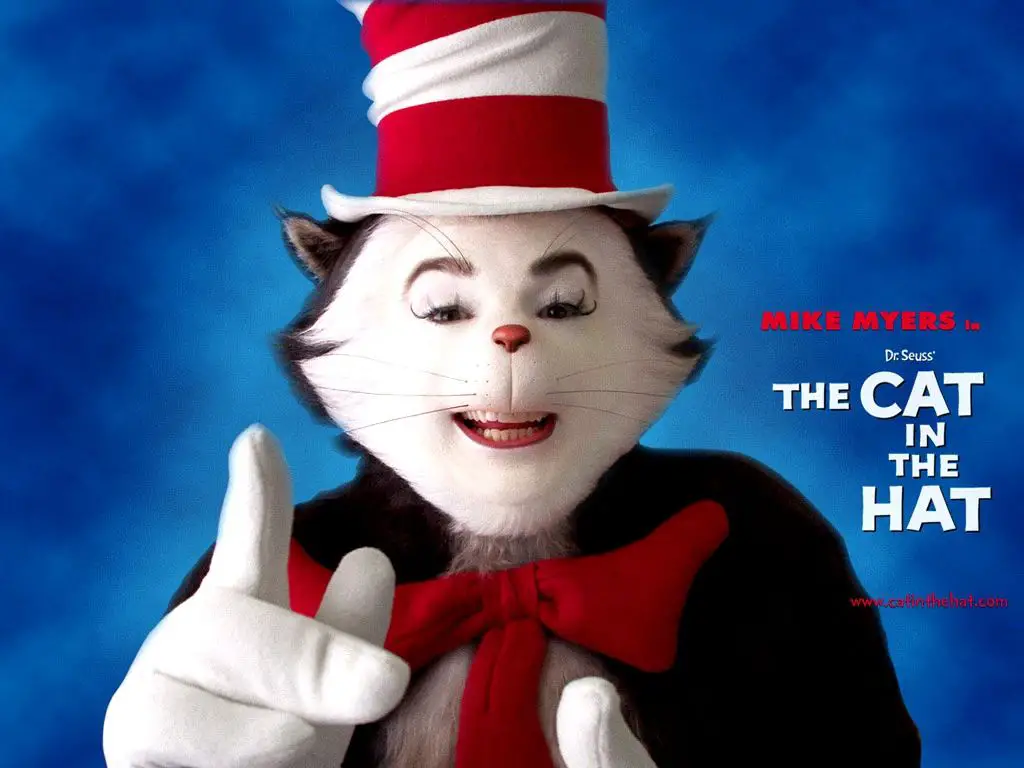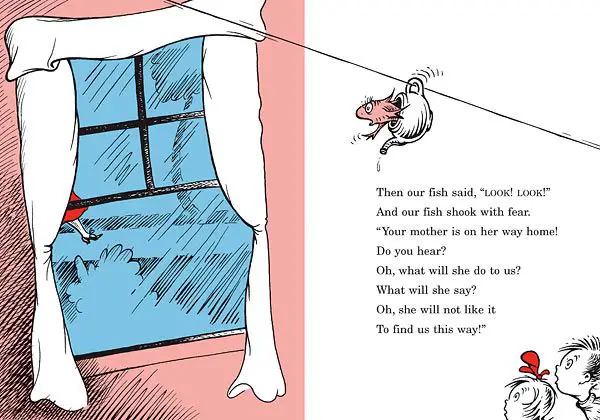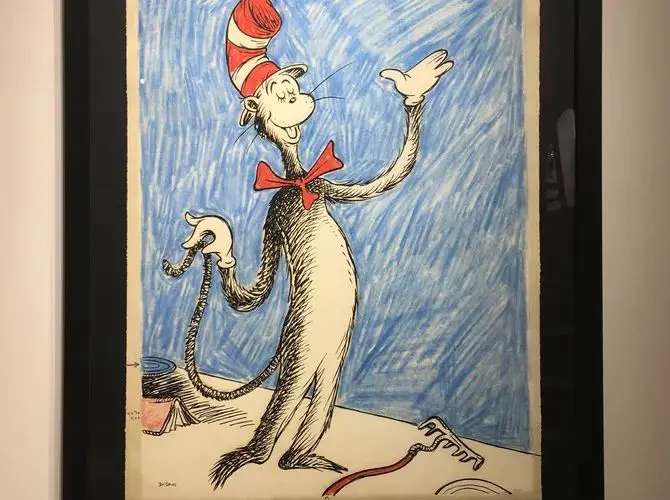The Cat in the Hat is a children’s book written and illustrated by Theodor Seuss Geisel, better known as Dr. Seuss. It was published in 1957 and was Dr. Seuss’ third children’s book. By 1957, Geisel had published multiple children’s books but struggled to produce a book that young readers would want to read on their own. After the publication of his previous book, The Cat in the Hat was created using only 236 different words from a pre-approved list of 348 words given to Geisel by his publisher. Despite the limitations, Geisel produced the classic book that is now beloved by generations of readers. The Cat in the Hat tells the story of a mischievous anthropomorphic cat who wears a tall, red and white striped hat. When two children, Sally and her brother, are left alone for the day, the cat unexpectedly shows up to entertain them. This leads to a series of chaotic events in the house despite the children’s attempts to keep things orderly and under control.
Plot Summary
The Cat in the Hat tells the story of Sally and her brother, who are stuck at home on a rainy day with nothing to do while their mother is out. Suddenly, a tall anthropomorphic cat wearing a red and white hat and a red bow tie appears at their house. Introducing himself as the Cat in the Hat, he offers to entertain the children with some tricks. The cat shows up when Sally and her brother are home alone. Despite Sally’s objections, the cat balances many household items on his hat and creates a huge mess in the house. Just as the cat promises to clean everything up, Sally’s mother arrives home.

Terrified that her mother will find the mess, Sally tries to have the cat leave before her mother sees him. The cat pretends to leave but pops back in, worsening the mess. He brings in two creatures named Thing One and Thing Two who start flying kites indoors. The entire house becomes even more of a disaster. In the end, the cat manages to clean everything up and disappear right before Sally’s mother comes in. With the mother none the wiser, Sally and her brother sit exhausted in the house that the Cat in the Hat left just as he found it.
Main Characters
The Cat in the Hat is the main character of the story. He is an anthropomorphic cat who wears a tall, red and white striped hat and a red bow tie. The Cat shows up at the house of Sally and her brother one rainy day when their mother is away. Despite the children’s rule to not let anyone in the house while their mother is out, the Cat barges in and causes mischief with his fun but troublesome games. The Cat seems to have good intentions in wanting to entertain Sally and her brother on the dreary day.
Sally is a well-behaved young girl who is hesitant about the Cat and his rambunctious fun. She tries to restore order when the Cat unleashes Thing One and Thing Two in the house. Sally also scolds the Cat and asks him to leave, but he persuades her to let loose and have fun.
Sally’s brother, who is unnamed in the book, is seen in the illustrations as a inquisitive young boy. He happily joins in the Cat’s games, unlike his more cautious sister. The brother seems unfazed by the increasing mayhem in pursuit of fun.
Thing One and Thing Two are two human-like creatures with blue hair who jump out of a big red box unleashed by the Cat. They run amok through the house, flying kites and knocking down everything in their path. Their wild and reckless behavior deeply worries Sally. The Cat struggles to control them once they are out of the box.
Key Themes
The Cat in the Hat explores several important themes related to imagination, adventure, and the consequences of actions. One of the central themes is the power of imagination. When the cat arrives, he brings a sense of play and fantasy that allows the children to envision new possibilities beyond their ordinary, mundane day at home. The cat’s magical hat and tricks transport the children on an imaginary adventure filled with make-believe creatures and situations. This theme demonstrates how imagination can open new worlds of excitement and fun.
Another key theme is that actions have consequences. While the cat’s visit is fun and thrilling for the children at first, his rambunctious behavior leads to their house being turned upside down into a huge mess. This demonstrates that unfettered fun and adventure, without considering the effects of one’s actions, can lead to unintended and messy consequences. The children must take responsibility for cleaning up the disaster created by the cat’s unrestrained play.
Overall, The Cat in the Hat explores imagination and adventure, but also responsibility and consequences through the chaos created by the cat. Children learn that unchecked behavior for fun’s sake can go too far and make a big mess they’ll have to fix.
Rhyming Style
One of the most distinctive aspects of The Cat in the Hat is Dr. Seuss’s use of rhyming couplets and rhythmic flow throughout the story. The text rhymes in an AA BB rhyme scheme, with couplet pairs neatly divided into even lines. For example:

“He saw mother’s new gown and her white nicotine gloves, And he said to the cat, ‘Now you jam up your jamb!’ But I like to be here. Oh, I like it a lot!” Said the Cat in the Hat to the fish in the pot.”
The rhyming couplets create a singsong, rhythmic flow that is easy for children to follow. Seuss also coined many made-up rhyming words like “bedspread,” “nicotine,” and “jamb.” This allowed him to maintain the rhyme scheme while expanding his vocabulary beyond actual words. The fanciful language is part of what makes Seuss’s style so unique and delightful. As one source notes, “Seuss twisted language to create rhymes and funky word combinations that didn’t exist before” (Mrs. Terri Costlow – Richland School District).
Impact and Legacy
The Cat in the Hat is one of Dr. Seuss’s most famous and beloved children’s books. Published in 1957, it has become a classic story that continues to captivate young readers. The book inspired the creation of several successful spin-offs and adaptations over the years.
The popularity and influence of The Cat in the Hat is immense. It is the ninth best-selling children’s book of all time, having sold over 7.5 million copies as of 2021. The famous character of the Cat in the Hat has become an icon of children’s literature.
In 1971, the book inspired the animated TV special The Cat in the Hat. It was so popular it was re-released in theaters in 1979. In 2003, the live-action film The Cat in the Hat was released staring Mike Myers. There have also been video games, plays, theme park rides, and other media featuring the Cat in the Hat.
The success and legacy of The Cat in the Hat stems not just from its humor and whimsical rhyming story, but also its goal to encourage children’s literacy. As cited in “Early Science & Engineering: The Impact of The Cat in the Hat Knows a Lot About That! on Learning” (CCT, 2019), Dr. Seuss wrote the book in response to a published report in the 1950s that criticized children’s dull reading primers. The Cat in the Hat shows reading can be fun and entertaining for children.
Literary Analysis
The Cat in the Hat is considered by many to have an unconventional plot. Rather than follow a typical narrative arc, the story is driven by the arrival and mischief of the Cat which disrupts the normal order of the household. The human-like Cat serves as a mischievous Trickster figure who brings chaos (1).
The story can be seen as filled with symbolism through its characters and props. For example, the Fish acts as the voice of reason and authority that the Cat subverts. The Cat’s hat symbolizes the imagination and fantasy he introduces into the children’s lives (2). The Cat himself serves as a larger symbol of unchecked id and rejection of norms.
The story has been analyzed as subverting authority. The Cat encourages the children to embrace mayhem and break rules set by their mother. The story shows the appeal of testing boundaries and chaos, which the Cat represents (2). Overall, The Cat in the Hat uses unconventional storytelling and symbolism to upend expectations of propriety.
Illustrations
The Cat in the Hat features illustrations drawn by Dr. Seuss himself in his signature cartoon style. The colorful drawings perfectly complement the rhyming nonsense text. The illustrations are simple yet imaginative, with curved lines, few details, and characters that appear in solid colors of red, blue, and yellow. According to an article on Pinterest, “Captivating Cat in the Hat Illustrations to Inspire Your Imagination,” Seuss’s drawings for The Cat in the Hat use only 236 different words but help to vividly bring the carnivalesque story to life (https://www.pinterest.com/ideas/cat-in-the-hat-illustration/903272964024/). The article showcases several of Seuss’s original illustrations for the book, highlighting his minimalist style. Downloadable Cat in the Hat coloring pages are also available that allow fans to engage interactively with the iconic drawings (https://mondaymandala.com/cat-in-the-hat-coloring-pages/). The illustrations’ simplicity, color, and perfect pairing with the story are key to the enduring appeal and recognition of the Cat in the Hat character and brand.

Adaptations
The beloved children’s book The Cat in the Hat by Dr. Seuss has been adapted into various mediums over the years. Some of the most notable adaptations include animated TV specials, a live-action film, and theme park rides.
In 1971, the book was adapted into a half-hour animated TV special directed by Hawley Pratt and starring Allan Sherman as the voice of the Cat. This was the first major adaptation of the story. It closely followed the original plot and visual style of the book (https://www.deviantart.com/stephen-fisher/art/The-Cat-in-the-Hat-2003-Review-842321027).
In 2003, Universal Pictures released a live-action film version directed by Bo Welch and starring Mike Myers as the Cat. The movie took creative liberties with the source material, expanding the story with new subplots and characters. It received poor reviews from critics but was a box office success (https://www.deviantart.com/ledorean/art/Twilight-approves-Cat-in-the-Hat-adaptations-908616137).
Theme park rides based on The Cat in the Hat have been built at several Universal Studios locations and SeaWorld Orlando. These dark rides take passengers through recreated scenes from the book and feature audio-animatronic characters.
Conclusion

The Cat in the Hat has had a significant cultural impact since its publication in 1957. The book has sold over 10 million copies worldwide and introduced generations of children to the joy of reading (Source). Its enduring popularity stems from its playful rhymes, engaging story, and memorable characters like the mischievous Cat in the Hat, Sally, and Thing One and Thing Two.
The book conveys important life lessons through its storytelling. It teaches children to have an open and curious mind but also to take responsibility for their actions. The Cat makes a mess but then cleans it up before Sally’s mother comes home. Ultimately, the book shows how even orderly lives can use a bit of fun and adventure as long as rules and boundaries are respected.
Over 60 years later, Dr. Seuss’s The Cat in the Hat continues to delight young readers. Its masterful blend of humor, rhyme, and imagination makes it a beloved classic that has stood the test of time.

